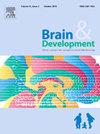与早期婴儿自发运动特征相关的脑形态学和围产期背景因素的检查
IF 1.3
4区 医学
Q4 CLINICAL NEUROLOGY
引用次数: 0
摘要
目的探讨极低出生体重儿(VLBWIs)早期婴儿全身运动(GMs)特征与临床背景因素(包括脑形态学特征)之间的关系。方法采用改良运动最优性评分法(MOS-R)对产后9 ~ 20周龄大鼠进行运动最优性评分。MOS-R由以下五个分量表组成:坐立不安运动质量(quality FMs)、运动模式(MP)、适龄运动曲目(AMR)、姿势模式(PP)和运动特征(MC)。使用经过验证的评分系统(MRI评分)对学期等效年龄的脑磁共振成像(MRI)进行评分。采用多元回归分析探讨影响MOS-R的因素。受试者纳入2012-2023年在大分大学医院管理的95例VLBWIs,这些患者接受了脑MRI和GMs评估。出生时的中位胎龄和出生体重分别为28周、6天和997 g。结果多元回归分析显示,MRI评分、动脉导管未闭(PDA)药物治疗、性别与MOS-R相关。在使用MOS-R亚量表作为因变量的分析中,质量FMs与MRI评分和性别相关;MP与MRI评分相关;AMR与PDA药物治疗、性别和产后类固醇使用有关;PP与估计分娩时的身高(EDC)相关;MC与PDA药物治疗和EDC体重相关。结论mos - r与脑形态发育有关。其亚量表受不同临床因素的影响。本文章由计算机程序翻译,如有差异,请以英文原文为准。
Examination of brain morphology and perinatal background factors associated with characteristics of early infantile spontaneous movements
Aim
To clarify the association between characteristics of early infantile general movements (GMs) and clinical background factors, including brain morphological characteristics, in very-low-birth-weight infants (VLBWIs).
Methods
GMs were scored using the motor optimality score revised (MOS-R) at a post-term age of 9–20 weeks. The MOS-R is composed of the following five subscales: quality of fidgety movements (Quality FMs), movement patterns (MP), age-adequate movement repertoire (AMR), postural patterns (PP), and movement character (MC). Brain magnetic resonance imaging (MRI) at term-equivalent age was scored using a validated scoring system (MRI score). Factors affecting the MOS-R were investigated using a multiple regression analysis.
Subjects
Ninety-five VLBWIs managed at Oita University Hospital in 2012–2023, who underwent brain MRI and GMs assessment, were included. The median gestational age at birth and birth weight were 28 weeks, 6 days and 997 g, respectively.
Results
The multiple regression analysis revealed that MRI score, patent ductus arteriosus (PDA) drug therapy, and sex were associated with MOS-R. In an analysis using the MOS-R subscales as dependent variables, Quality FMs were associated with MRI score and sex; MP was associated with MRI score; AMR was associated with PDA drug therapy, sex, and postnatal steroid use; PP was associated with height at the estimated date of confinement (EDC); and MC was associated with PDA drug therapy and body weight at EDC.
Conclusion
MOS-R is associated with brain morphological development. Its subscales are influenced by different clinical factors.
求助全文
通过发布文献求助,成功后即可免费获取论文全文。
去求助
来源期刊

Brain & Development
医学-临床神经学
CiteScore
3.60
自引率
0.00%
发文量
153
审稿时长
50 days
期刊介绍:
Brain and Development (ISSN 0387-7604) is the Official Journal of the Japanese Society of Child Neurology, and is aimed to promote clinical child neurology and developmental neuroscience.
The journal is devoted to publishing Review Articles, Full Length Original Papers, Case Reports and Letters to the Editor in the field of Child Neurology and related sciences. Proceedings of meetings, and professional announcements will be published at the Editor''s discretion. Letters concerning articles published in Brain and Development and other relevant issues are also welcome.
 求助内容:
求助内容: 应助结果提醒方式:
应助结果提醒方式:


